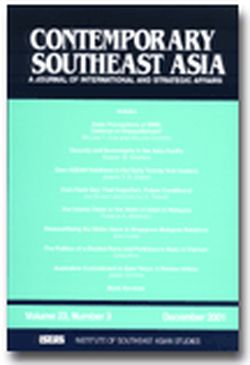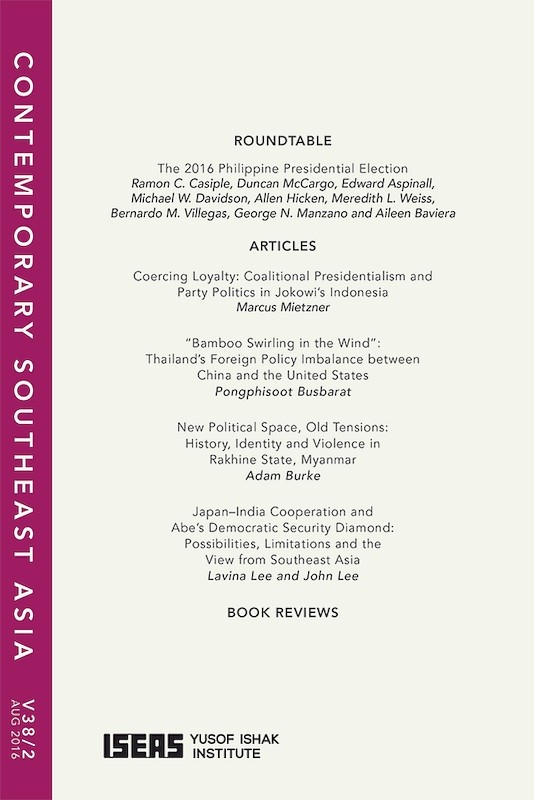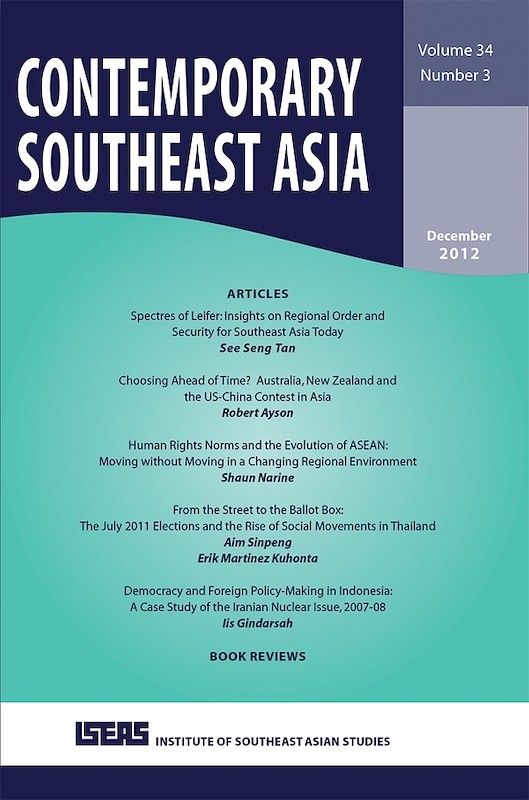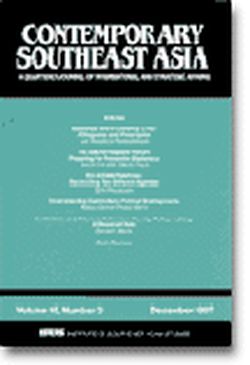Contemporary Southeast Asia Vol. 30/1 (Apr 2008)
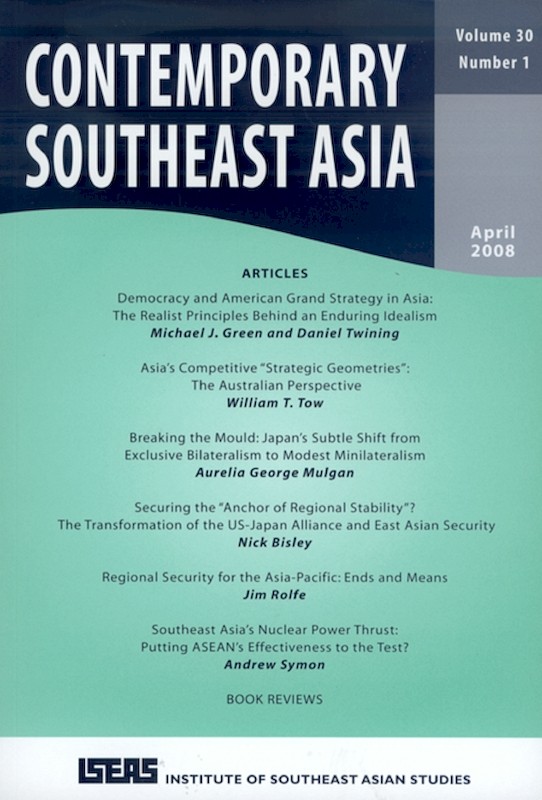
Date of publication:
May 2008
Number of pages:
158
Code:
CS30/1
Contents
-
Contemporary Southeast Asia Vol. 30/1 (Apr 2008)
[Whole Publication] -
Preliminary pages
- ARTICLES
-
Democracy and American Grand Strategy in Asia: The Realist Principles Behind an Enduring Idealism, by Michael J Green, Daniel Twining, authors see abstractHas democracy promotion been discredited as a central theme of American foreign policy after the US experience in Iraq? Many American critics and friends overseas appear to believe so. It would be wrong, however, to believe that the ideational approach of American foreign policy will diminish, particularly in Asia. First, there is not in fact a tension between the United States material power and its ideals as a democracy. Second, post-Bush leaders identify and embrace the promotion of bilateral and multilateral cooperation among Asia-Pacific democracies as central to the United States regional strategy. Third, and most important, democracy promotion and security cooperation among like-minded democracies will remain a central objective of American foreign policy in Asia because those elements magnify American power and facilitate US goals. In short, the ideational balance of power in Asia directly affects the material balance of power. This article examines these trends in American policy in Asia, the outlook for greater strategic and diplomatic cooperation among regional democracies, and the implications for the region, including China and ASEAN, of a US democracy-based approach to Asia policy.
-
Asia's Competitive "Strategic Geometries": The Australian Perspective, by William Tow, author see abstractRecent changes of government in Australia and Japan, and a pending one in the United States, signifies a historical crossroads in these three allies' security politics in the Asia-Pacific region. In recent years, all three countries have tended to rationalize their strategic collaboration on the need to build innovative and competitive-oriented "strategic geometries" as a means to counter China's growing power and to meet new types of threats in the region. Yet the Australian Government under John Howard simultaneously pursued a hedging strategy, exploiting its growing economic relationship with China while strengthening its diplomatic and strategic profile with the United States. Despite Tokyo's own substantial economic relationship with Beijing, recent Japanese leaders were unable to pursue the same type of "dual track" strategy to the same extent as Howard. With Kevin Rudd's election as the new Australian Prime Minister and Yasuo Fukuda's ascent to power in Japan, prospects for Australia and Japan to cultivate more independent politico-security ties with Beijing have strengthened. If so, the evolving regional security postures of both these US allies may compel the United States to reassess its own traditional skepticism towards multilateral security groupings in the region.
-
Breaking the Mould: Japan's Subtle Shift from Exclusive Bilaterialism to Modest Minilaterialism, by Aurelia George Mulgan, author see abstractNeo-realists argue that Japan's response to the rise of China has been to draw closer to the United States in order to balance Chinese power. In practice, the Koizumi and Abe administrations differed in their responses to the growth of Chinese power in East Asia. While Prime Minister Koizumi sought to consolidate the US-Japan alliance, Prime Minister Abe adopted a dual-track approach, combining enhanced bilateralism with enhanced regionalism. Although buttressing the US-Japan alliance, this strategy aimed to balance China by building a containment coalition with other Asia-Pacific states. Japan's signing of a security declaration with Australia in March 2007 was an important element of Abe's strategy, and marked a subtle shift in Japanese security policy from exclusive bilateralism to modest minilateralism. Although congruent with US strategic interests, this move supported Prime Minister Abe's ambition to exercise more autonomous influence over the regional security order.
-
Securing the "Anchor of Regional Stability"? The Transformation of the US-Japan Alliance and East Asian Security, by Nick Bisley, author see abstractOver the past decade, the US-Japan alliance has been strengthened and subtly but substantively transformed. In response to a range of domestic changes and new international challenges, a relationship that was becoming frayed in the immediate aftermath of the Cold War has been rejuvenated and re-tooled with significant consequences for East Asia's strategic setting. This article provides a critical analysis of this process with two ends in mind. First, it provides a systematic overview of the changes, their sources and what they mean for the alliance partners and their security interests. It argues that the US-Japan alliance now has two distinct functions, one relating to regional stability and the other focusing on shared global strategic aims. The alliance is in good health, but its continued vitality will require careful management. Second, it assesses the regional consequences of this change and argues that while alliance enhancement has been intended to promote mutual and regional security there is reason to doubt whether the latter goal has been served through the enhancement process.
-
Regional Security for the Asia-Pacific: Ends and Means, by Jim Rolfe, author see abstractDespite calls over the years for the Asia-Pacific region, or some sub-set of it, to develop a regional security regime, no deliberate action to achieve this has been taken. This paper considers the possible ends of a regional security regime and the means towards achieving them. The ends themselves would differ according to whether any regime focused on security, traditionally and narrowly conceived, on comprehensive security or on human security. No matter which approach is taken, if the regime is to be successful in any sense beyond that of rhetoric, some of the regions cherished norms such as non-intervention as that is currently interpreted will have to be at least modified, if not completely scrapped. Even if the region collectively decides it needs a security regime and can agree on its ends, there are many alternative ways of achieving the ends and the processes of working out detailed rules will be difficult and time-consuming. None of this is to say that establishing a regional security regime will be impossible. It is to say that it will involve a lot of work, and a lot of compromise by state policy-makers.
-
Southeast Asia's Nuclear Power Thrust: Putting ASEAN's Effectievness to the Test?, by Andrew Symon, author see abstractThe possibility of nuclear power in Southeast Asia to help meet huge growth in electricity demand has suddenly risen in government planning. Vietnam, Indonesia and Thailand have plans for nuclear power generation while Malaysia and the Philippines are studying the option. These plans and possibilities raise a gamut of economic, environmental and security issues and fears which policy makers are only beginning to grapple with. As in other parts of the world, both where there are established nuclear generation industries and where there are not, nuclear power is being turned to as a possible solution to meeting demand when the cost of traditional fossil fuels used for generation, coal and natural gas, are rising steeply, and in a way that mitigates against contribution by fossil fuel combustion to the greenhouse effect and predicted global warming. But how governments in Southeast Asia go about implementing nuclear power is still far from clear. Optimal development from economic, environmental and security points of view would argue for a cooperative approach via the Association of Southeast Asian Nations (ASEAN), possibly through an ASEAN nuclear power authority. So far, plans for nuclear power generation are fairly limited when considered against total projected power demand. But they may be the precursor to a much greater commitment to nuclear power if first plants are successfully developed. Managing the development of nuclear power will be a major test of ASEAN's maturity and effectiveness.
- BOOK REVIEWS
-
BOOK REVIEW: International Democracy Assistance for Peacebuilding: Cambodia and Beyond, by Sorpong Peou, and Dancing in Shadows: Sihanouk, The Khmer Rouge, and the United Nations in Cambodia, by Benny Widyono, by Annette M Clear, author
-
BOOK REVIEW: Indonesia, Islam, and Democracy: Dynamics in a Global Context, by Azyumardi Azra, by Victor J Sensenig, author
-
BOOK REVIEW: America's Strategy in Southeast Asia: From the Cold War to the Terror War, by James A. Tyner, by Sheldon W Simon, author
-
BOOK REVIEW: Beyond Japan: The Dynamics of East Asian Regionalism, edited by Peter J. Katzenstein and Takashi Shiraishi, by Eul-Soo Pang, author
-
BOOK REVIEW: A Handbook of Terrorism and Insurgency in Southeast Asia, edited by Andrew T.H. Tan, by Paul Smith, author


